Team 18: Annabelle Wang, Carina Fung, Jared Poblete, Madison Fan, Serena Kravantka
Problem Domain and Motivation
Humans are naturally social creatures—we need family, friends, and strong support systems to get by. Forging these relationships is crucial for our well-being and happiness, and it even affects our physical health. Life transitions such as the move to university afford students a new world to explore, new stories to tell, and new lifelong friendships to blossom.
However, with all the ups and downs that life throws at us, it isn’t always easy to maintain relationships in a sustainable fashion. Students naturally struggle with miscommunication, incompatible schedules, and ever-changing circumstances. Often, these invaluable connections wither away or are outright abandoned. (There’s only so much a When2meet can solve!) How many times have you and a friend agreed to “grab coffee” as a gesture, an appeal to niceties, only to forget the moment after? With our group comprised mostly of upperclassmen, we’re personally invested in tackling the problem of meaningfully maintaining relationships throughout the transition of graduation.
Baseline Study
Our original target audience primarily consisted of young adults between the ages of 20-30. We used our screener to narrow our focus to college students who indicated that they wanted to feel more connected to their friends than they already did. Based on this metric, we had 21 screener responses and 12 participants for the study, who we then proceeded to conduct pre-study interviews with. The main purpose of the pre-study interviews was to determine how each participant currently chose to maintain relationships through anecdotes of their attempts to maintain relationships with others—successfully and unsuccessfully.
Once pre-study interviews were completed, we began our week-long diary study. Participants were asked to fill out a Google Form after every in-person interaction. Through this, we were able to obtain 128 responses which allowed for some fallout buffer amongst the 12 participants.
Baseline Study Synthesis
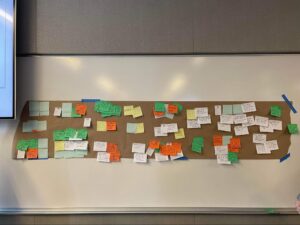
To synthesize our findings from the baseline study, we created affinity and frequency groups with key insights. Our main takeaways on self-initiation and convenience led us to create comparative matrices.
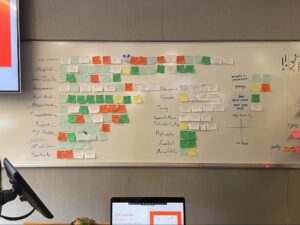
The first comparative matrix we made measured Quality of Relationship versus Effort of Interaction, with our second matrix iterating on the idea: Satisfaction versus Stress. We defined “stress” here as both effort and emotional investment. High Quality + High Effort was our most populated quadrant, where conscious efforts such as planning proved to be the most emotionally rewarding. This led us to believe any app we would make would have to convey a user’s intentionality behind their actions.
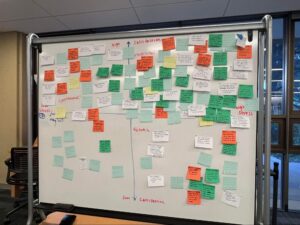

To flesh out our understanding of how people interact, we constructed a connection circle dedicated to failure in maintaining relationships along with reinforcement loops to visualize the role of the key factors of stress and satisfaction in relationships. From these, we determined that “reaching out” is one of the main hurdles in establishing and maintaining relationships; fear of social norms and fear of not being reciprocated make relationships more difficult to navigate.
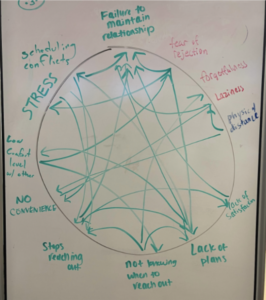
See our full baseline study synthesis here.
Comparative Analysis
In our comparative analysis, we identified ten social apps that approached maintaining relationships differently including automation, signals and photos over text, and social media messaging systems.
Our comparative analysis showed that some automated suggestions proved very effective for helping users track how and when they reach out. Reminders were the main feature of some apps, and while notifications in some form are effective, our team wanted to steer away from heavy reliance on reminders. We saw the impact photos could have on increasing mood and emotional connection, so we want to include photos in some major capacity. We would like our app to help users build up their individual relationships, so our goal is somewhere between being extremely personalized (e.g. photos album) and too widespread (e.g. social media).
Using our findings, we drew out a comparative matrix measuring activation against intervention and identified two potential areas in the market to disrupt. We decided to move forward with the High Intervention + Low Activation quadrant; it was the clear middle ground between creating a social media app and a passive app like BeReal.

See our full comparative analysis here.
Literature Review
Key insights gathered from our literature review:
- Life Satisfaction: Positive life satisfaction is correlated with intense (i.e. frequent interactions) quality friendships.
- Generally, happiness in life is associated with close personal relationships.
- Reciprocity: Every relationship requires some degree of reciprocity to last, yet there are different expectations of reciprocity for different levels of relationships.
- Satiation theory: The need to belong conforms to patterns of satiation and substitution. People need a few close quality relationships, and forming additional relationships have less and less impact beyond those few.
- Distance and Time: The time of the last contact may not affect emotional closeness. Larger social networks beget longer time to contact individual friends despite emotional closeness. Distance might be more relevant than time to fostering emotional closeness.
See our full literature review with links and summaries here.
Personas and Journey Maps
See our personas and journey maps here.
Intervention Study: Product Ideation
See our full deliberation of intervention and product ideation here.
Intervention Study: Logistics
Our final idea for the intervention study: each night, participants choose one photo memory with a friend, and text that person their respective shared photo. The hypothesis of the study includes the following:
Sending photo memories…
- Provides a conversation starter for relationships that haven’t been maintained
- Lets the friend know that the participant cares about them
- Deepens relationships
Since we decided to focus on graduating students facing a life transition, we selected 6 new senior/co-term students in addition to 5 baseline-study participants. We conducted pre-study interviews for new participants to understand how they currently maintain relationships and how they feel about their relationships post-graduation.
Based on TA feedback, we sent email reminders each morning and night of the study to prime them for the day and remind users of the intervention respectively. We collected study data across 5 days by prompting the users to fill out a Google Form at the end of each day; we gathered 34 responses over the course of 5 days.
After the intervention study, we created a post-study survey to understand experiences in the intervention. We received 7 responses from our 11 participants.
Intervention Study: Synthesis
With data from our pre-study interviews, intervention study, and post-study survey, each team member wrote post-its on insights and key data for team synthesis. We followed suit with the synthesis methods from our baseline study.

From our cluster grouping: participants noted the experiences of searching for a photo memory elicited nostalgic and happy feelings, and demonstrated higher confidence in the action of reaching out after the intervention.
Quoting one participant, the study “made [them] realize it’s not that deep”: the simple action of sending a photo can be a deceptively effortless way of reaching out. Moreover, photo memories prompted participants to reach out to more distant relationships—relationships that are physically displaced or left uncontacted for a long duration of time—and validated our intervention study hypothesis that a photo-memory approach would deepen relationships despite existing or upcoming distance.
Participants noted the frequency of reaching out nightly felt tedious. Initiating too often not only felt like a chore, but also made participants feel less genuine. Rather than reaching out because they genuinely missed someone, they felt like they were reaching out as a prompt. Moreover, overly frequent initiations required participants to juggle similar conversations simultaneously, which felt repetitive and overwhelming. One main concern of our current intervention plan is that it places the onus of relationship preservation on the user, while we found in our baseline synthesis that “a relationship is a two-way street.”
Another pain point of note is that users felt nervous about the initiation until a response was received. In our study, we found that nervousness is generally influenced by fear of reciprocity. While most participants reflected they eventually felt happy about reaching out on receiving positive responses, the anxiety colored the rest of the experience. Similarly, we found participants feel stressed about reaching out because they often feel guilty for falling out of contact with the other person.
We created a connection circle model to see how our key insights from cluster grouping interacted with each other.
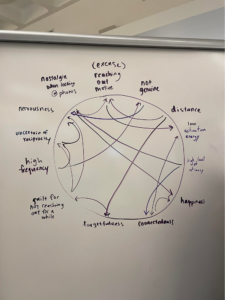
We were surprised to find that participants felt justified to reach out only when the relationship involves physical distance or has not been maintained in a long time; the need for a justification for reaching out was unexpected.
A high frequency of reaching out reduces the justification for reaching out. On the other hand, a high frequency of not reaching out leads to feelings of disingenuity from the participant’s end, as well as increases the participant’s doubt of reciprocity.
We also created a reinforcement loop from the connection circle to find a relationship between effort and emotional closeness.
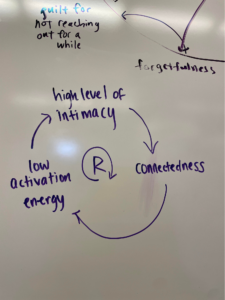
Moving forward, we will aim to find a solution that alleviates these existing barriers in reaching out (see: the Low Effort + High Intervention quadrant of our comparative matrix from our competitive analysis).
Storyboard & Stories
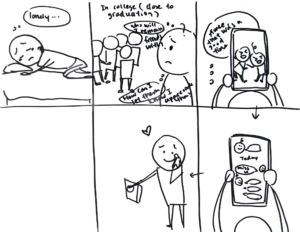
This storyboard demonstrates how a college senior (MC) could feel lonely as they approach graduation. They’re unsure of who they will remain friends with and how they could show appreciation to the friends they want to keep. Upon seeing a photo memory that strikes an emotional chord with the MC, they send it to a friend. The photo initiates a conversation, which leads to the MC feeling nostalgic and more connected to their friends.
We also constructed a user story from the storyboard:
- I am a senior and I have been feeling worried about what my friendships from college will look like after graduation. Who will I remain friends with? How can I remain friends with them? I want to feel confident in my friendships before I graduate.
This storyboard represents the goal of our product: to use memories as a catalyst for maintaining relationships despite upcoming life transitions that might distance the user from their friends. We recognize the high activation energy required from the user to reach out and want to ease that burden. This would help us distinguish ourselves from similar products like Snapchat Memories, which requires the user to reach out with photos on their own accord.
Current Direction and Next Steps
Our research validated most of our assumptions. Our intervention participants found the interactions positive and the experience enjoyable, with many saying that they would do something similar again. The act of discovering photos to send was “super nostalgic and fun,” and reciprocated messages helped one participant to realize that “time and distance between myself and an old friend doesn’t need to be a barrier to connecting with someone.”
From our findings, we feel that our solution needs to include the removal or reduction of barriers to communication. From both the baseline and intervention study, we saw that many people had negative feelings about reaching out due to how long it had been since they had contact. This was a major behavior tension considering participants self-selected to reach out to connections that they hadn’t spoken with in at least a few months, despite the fact that it was a common cause of discomfort. The photograph acted as a barrier reduction since it “gave a reason” to reach out that made it less awkward. For these reasons, a key feature we’ve decided to move forward with is the inclusion of photographs as a means of barrier reduction when initiating conversations with distant contacts.
However, we want to create interactions that are genuine while still being assisted by our solution. Daily initiations “felt like a chore” and “disingenuous” because of the frequency. To ensure that interactions are nudged instead of pushed, we intend to give users control over the frequency and timing of reminders that we may send out.
Based on our conclusions, we plan to create a solution that reduces barriers to rekindling distant relationships without promoting disingenuous interactions. Balancing ingenuity and automation will be one of our biggest challenges in the coming weeks as we further build our solution, as well as appeal to our main focus group of graduating students.
To the teaching team and reviewers,
- How best can we reduce the mental load of our users? Are notifications helpful reminders or harmful noise?
- Are photographs an appropriate scope? Should we expand to more forms of “digital memories” like video and text?
- Who should be the driver behind discovery: the app or the user?
- What form (mobile app, widget, etc) is most appropriate for the kind of solution we’ve outlined?
- How might we tailor this to our proposed demographic?
- Are there insights that you found in our research, or your own personal experiences, that we failed to address?
We’ve been having a lot of fun in our process. Here’s the evidence:
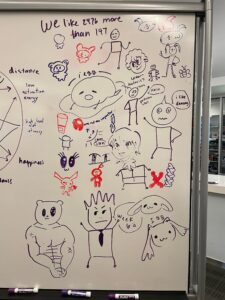
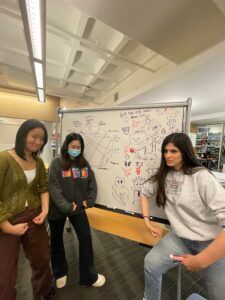
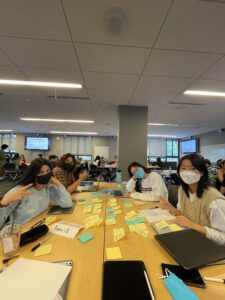
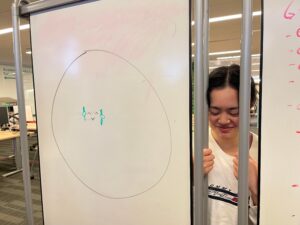
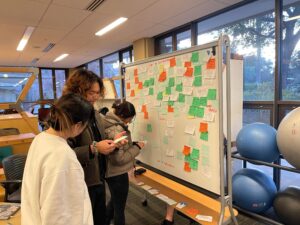
Hope you enjoyed!
Signing off,
Team 18



